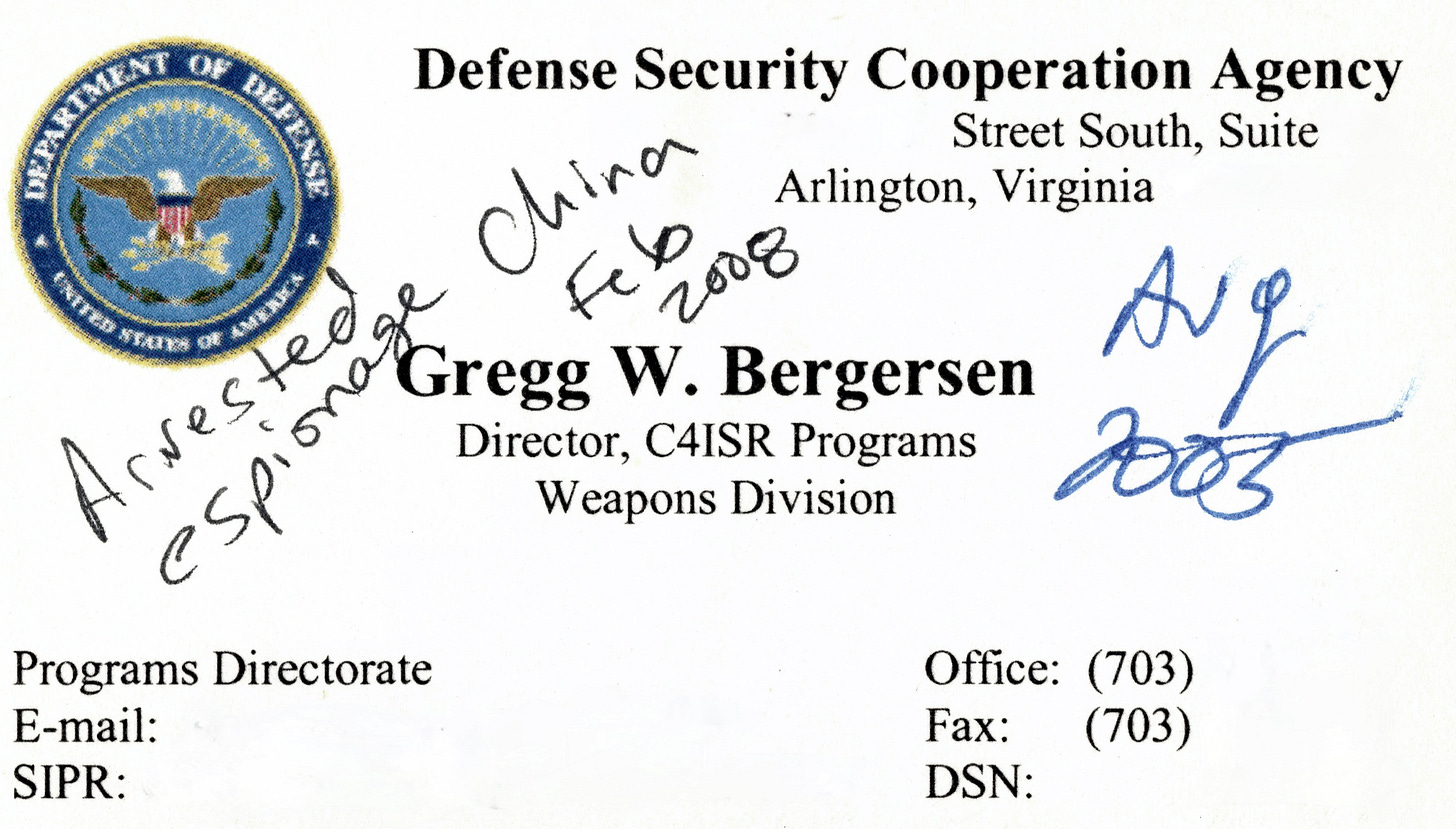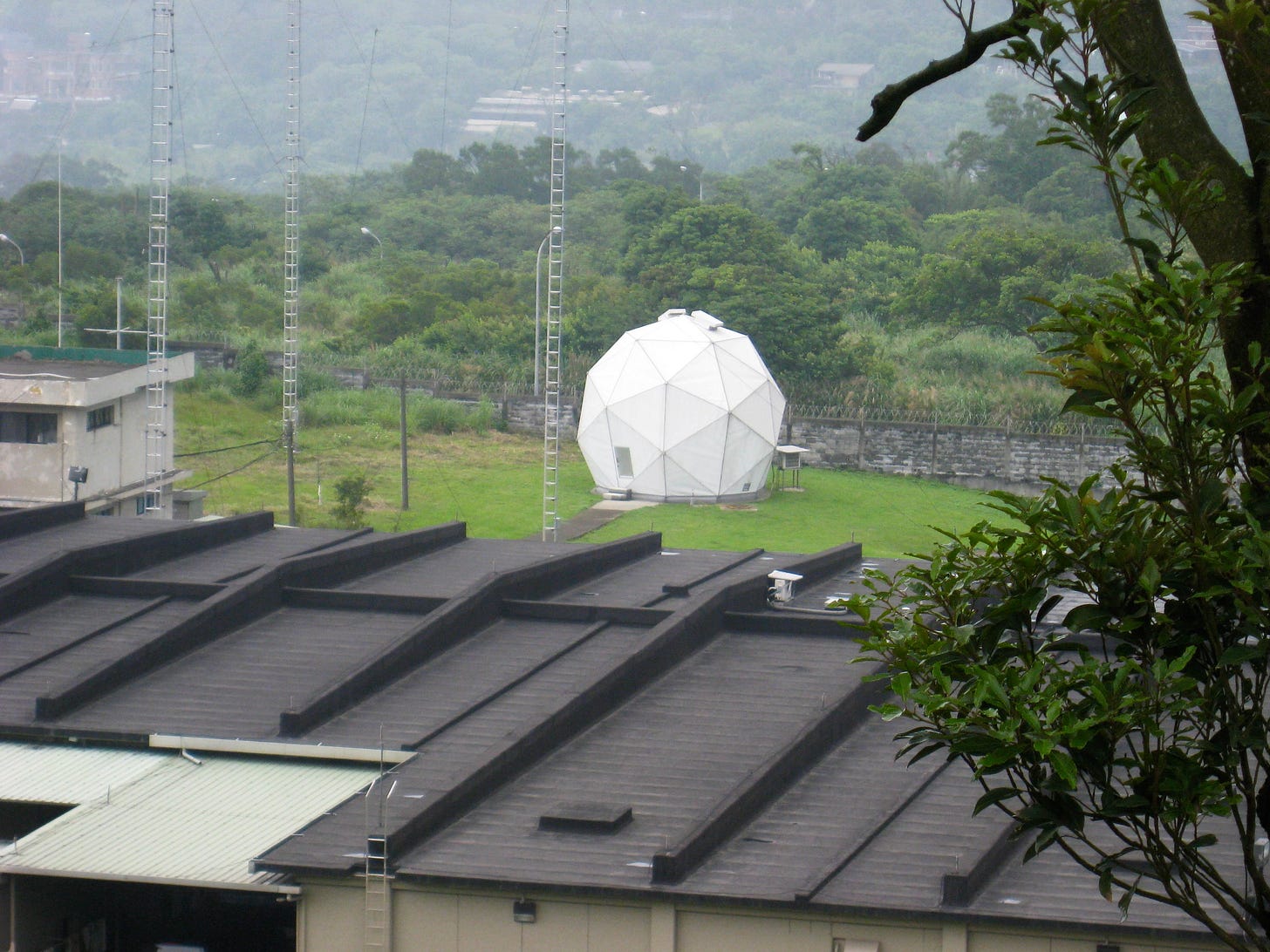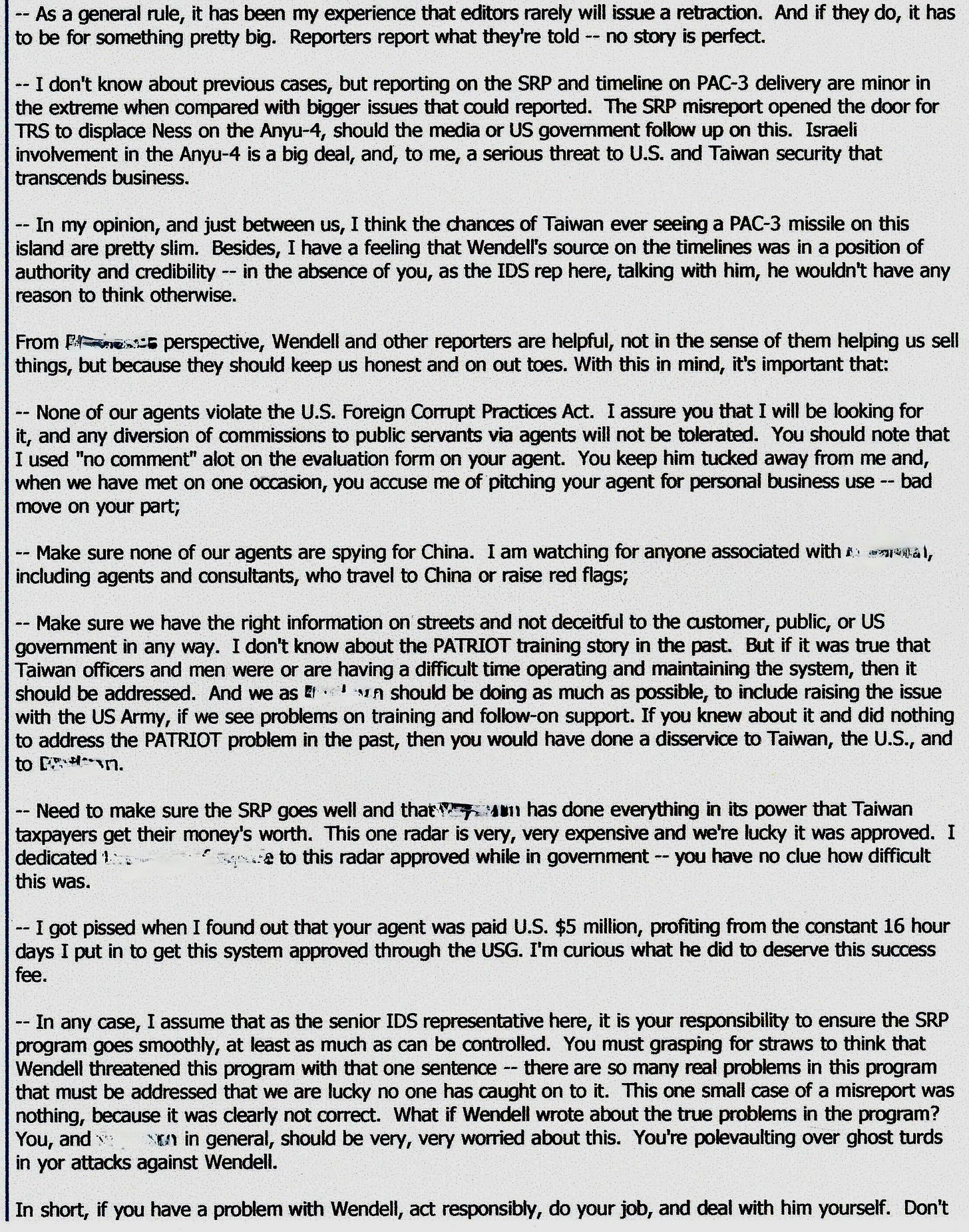China In Arms BOOKSTORE and GIFT SHOP!
Follow on Twitter
Subscribe: $5 Month/$50 Annual (unable to secure a subscription contact the bank for permission for Stripe deposits).
Paid Subscriptions can choose 2 free books.
NOTE TO READER: This article was updated on 30 March 2023 (Thursday) due to additional information.
30 March 2023 (Thursday)
Taiwan Radar - Corruption and Espionage
Documents Point to Confusion Over SRP
By Wendell Minnick (Whiskey Mike) 顏文德
TAIPEI - As a journalist, what is it like to write about multi-million dollar programs that have everything on the line: careers, financial stocks, government corruption, espionage, and ultimately the existential survival of Taiwan?
I am not trying to paint myself as a hero or a “real journalist asking tough questions”, but I do want to give the reader a glimpse into my world over the past 30 years.
Taiwan had originally planned to build two advanced early warning radar facilities under the Surveillance Radar Program (SRP).
But competition between Lockheed and Raytheon caused significant angst and delays in the 2000s.
The below e-mails are redacted, but do reflect Raytheon’s rage over my reporting and their continued, but failed, attempts to control my reporting for Jane’s Defence Weekly and later Defense News.
You will note in the below e-mail that Raytheon sent numerous complaints to my editors, in vain.
Things got so bad that a representative of the SRP in the U.S. government attempted to hit me with a beer bottle in the sleazy Combat Zone red light district. It ended badly for him, for I have no tolerance for fools.
Taiwan’s SRP, first initiated in response to the 1995-1996 Taiwan Strait missile crisis, aimed to provide Taiwan with the ability to detect both air breathing, ballistic missile threats and even satellites.
The original plan was for two facilities. One at Leshan Mountain and another at an undisclosed location in the south.
The southern facility was canceled after encountering obstacles from a Buddhist organization that had to move a monastery. Yet the monastery was not the only problem.
The northern SRP at Leshan was hit by massive cost overruns that went from $800 million to $1.6 billion. No joke.
The radar is an over-the-horizone (OTH) UHF and there is nothing like it in history, including the legendary U.S. PAVE PAWS.
The SRP has one catch for the Taiwan military. The complexity of the system forced Taiwan to accept U.S. control over the radar and provide U.S. contract technicians to operate the facility.
The U.S. also has full access to the radar’s intelligence on China. The radar’s computer programming and processing was developed by Johns Hopkins University.
Other joint ventures between the U.S. and Taiwan, include the U.S. National Security Agency (NSA) and the Taiwan National Security Bureau (NSB) at the Signals Intelligence (SigInt) antenna facility on Yangminshan at Pingtun Li that listens to China.
Photographs of SigInt site by Wendell Minnick:
A U.S. government source on the SRP stated the following:
“It's powerful due to size and aperture. But what really makes it powerful is the software that can handle a huge amount of tracks. As far as I know, it can handle not only air tracks (planes, cruise missiles, and UAVs) and ballistic missiles, but also sea tracks and satellites. The real question is whether the U.S. actually would have real time intelligence from the radar feed.
First, if such arrangements would be or had been made, you should see some cost sharing arrangement. It would be really bad form for the U.S. to demand Taiwan cough up an additional $125 million. The additional $125 million would cover the additional cost associated with the roads that keep washing out. I think managers are smarter than trying to lobby Taiwan to share the SRP picture without some cost sharing arrangement.
Secondly, even if program managers did work out a cost sharing arrangement, I don't think US policymakers would consent to have this kind of real time operational linkage with Taiwan. It would imply Taiwan is part of a US global missile defense system. This is something that Beijing would have a hard time with.
The benefits of getting that feed for peacetime monitoring of the air environment don't seem worth the costs. It could add some in terms of covering air activity further inside China, above and beyond getting Taiwan's current air picture. But there are line of sight limitations - the further the range, the higher in altitude those aircraft would be. For example, to cover air activity out of Wuhu [in Anhui Province], an aircraft would need to be pretty high to pick it up due to the curvature of the earth.
In a conflict situation, especially a full scale conflict, the SRP has one mission - early warning of initial missile and air strikes. Once it does its job, it's not realistic to assume the radar would survive past initial missile strikes. In a large scale air and missile campaign, the SRP would be a priority PLA target.
Having said that, if the PLA did decide to launch anti-ship ballistic missiles [ASBM] against U.S. aircraft carriers, before or without striking Taiwan, then this is where that radar feed [to the U.S.] could do some good. The PLA looks like it could be developing means to counter U.S. space-based missile early warning systems. If China's ASBM [anti-ship ballistic missiles, e.g. DF-21/26] adopts mid-course maneuvering, we would need to have a radar to maintain a good track on the missiles. We do have X-Band GBRs [Ground Based Radars via Japan’s Ryukyu Arc] in the region. They have limitations though. A UHF radar feed could be very useful in a scenario in which China made a very unfortunate decision to launch an ASBM strike against U.S. aircraft carriers without striking Taiwan. Unlikely, but possible.
Taiwan does need to be able to track PRC satellites. And Taiwan needs additional resources to track maritime activity. The SRP should be able to do both, and if so, Taiwan could use these additional capabilities. At no extra cost...
A commercial spin off of Johns Hopkins Applied Research Lab supposedly did the software development for the radar. The capabilities are said to be the most well developed in the world. Of course that software package could be used for other USAF, MDA [Missile Defense Agency], and other DoD programs. I would not be surprised if it would be used to support missile-defense related UHF radar programs in Europe for example. Taiwan theoretically could ask for a version of that software package - minus the source code - for its own C4ISR programs. For example, it could use that software to integrate various sensors into a common picture for military and civilian watch centers
Don't forget that a major part of the cost of the Po Sheng program was software also [Po Sheng program provides for the integration of Taiwan air, ship, ground, and command and control assets using a joint command, control, communication, computer, intelligence, surveillance and reconnaissance or C4ISR system enabled by tactical data links].
Seems like a less than optimal use of funds that Taiwan is having to pay for major software programs [that will also benefit] both the U.S. Navy and U.S. Air Force. Both likely would be used to support other programs.
You want to really stir up shit? Start asking if offset obligations have been satisfied on the SRP. Taiwan requires that U.S. companies incur an offset obligation of 30 or 40 percent of the total contract value on FMS [Foreign Military Sales] and DCS [Direct Commercial Sales] programs.
For an $800 million dollar contract with the USAF for the SRP, this means an obligation of around $300-400 million. When you add in multipliers that Taiwan would offer for specific projects meant to satisfy that obligation, it means around $30-40 million in real money that a contractor would have to spend in various kinds of initiatives that may or may not be directly connected with the SRP. This amount normally is an allowable expense that would be estimated in advance and put into the contractor's contract with the USAF.
As far as I know, the company responsible has just completely blown it off. They probably would say "we don't have that $30-40 million available to satisfy that offset obligation." But where is that money?
If it was added into the contractor's contract with the USAF, that cost would be passed on in the LOA [letter of acceptance] that the USAF would have signed with Taiwan back in 2005. If the contractor did not budget for it, then they screwed up.
There is still an obligation that has to be satisfied one way or another. Taiwan's rules are clear, and most companies satisfy their obligations. According to USG [U.S. Government] rules, the USAF doesn't care. It's the contractors problem, and USG doesn't get involved in offset issues, beyond allowing contractors to include the estimated costs of offsets in their bill to the USG.
This is a big problem, and I suspect the contractor is walking on eggshells about any media reporting about it. Protect me on this one, but it is a serious problem and a possible black mark on US credibility. USG policy is to not get involved in offsets. But they still allow for the LOA to be used as a pass-through vehicle so that the US company doesn't have to take offset costs out of their profit margin.
In this case, the contractor may be refusing to even commit to satisfying its obligation, apparently confident that Taiwan can't do a damn thing about it. And it may be true - what could the Taiwan’s Legislature do? Say they won't buy anything else from this company? They can't, because they are really buying from the USG.”
The information above was included in separate articles written in both Jane’s and Defense News. I moved from Taipei correspondent for Jane’s in June 2006 to Asia Bureau Chief for Defense News.
Below Raytheon reacted to my reporting in an angry e-mail exchange with various sources in both the defense industry and the U.S. government assisting me in my reporting; below is late 2006 while with Defense News:
Response from Raytheon complainant:
Below retort from my source to complainant; there is a subtle reference to two Taiwanese spying for China who were working on the Po Shang, Anyu-4 Air Defense Upgrade, and the SRP: Ko-Suen "Bill" MOO and Tai Shen KUO. There is also a reference to questionable Israeli involvement via Moo. I have the name cards, available at the bottom of this article.
There was one response to this post after filing that contradicts some of the above comments. This is from a senior U.S. government source on the program:
There is a major discrepancy concerning SRP offset. "Offset" also know as Industrial Cooperation Program (ICP) is not free as many people mistakenly thought. It is a cooperative program. Offset administration cost is embedded in the major system procurement cost (often Line 1 of the LOA) that is funded by the buyer. This fund is used to execute the ICP program. The main benefit of ICP is not free this or free that, because nothing is free. It is technology transfer. For SRP, the money that was originally set aside for ICP in the FMS case (that $30-40 million dollars you mentioned in your story), at Taiwan's request, was refunded back to Taiwan. So, there was no money to execute the ICP when needed (even though US contractor asked USG to keep the money in the case). U.S. government program manager gets direction from the customer not the contractor so the money was refunded. Some officers in Taiwan even received medals for getting so much money back from the SRP FMS program. But, now everyone avoids talking about how the SRP ICP became dead. If what you said in your article about blowing off the ICP is true, there would have been a major lawsuit. There isn't, because the USG has clear track of the money, it went back to Taiwan.
The decision to refund the money was made by people who have no idea of how the ICP worked both from the USG and TAF [Taiwan Air Force]. ICP actually is not such a good deal people made it out to be. The buyer actually pays for the stuff they get through ICP. They just don’t have visibility of it. People always question the price of FMS cases, well, if ICP administration costs are added into each FMS case with ICP obligation, it should not be a surprise to anyone the price seems high.
To clarify. For offset, the money is within the FMS case, contractor requests for it when the customer agrees to an offset project. The contractor bills the FMS case for offset related activities then the USG allocates the money. The USG is not party to the off-set but controls the money to ensure all expenditures are legitimate. The offset money originally in the SRP case was returned to Taiwan Treasury at Taiwan's request thinking that was "excess" money. The contractor advised both USG and Taiwan against it but it was unsuccessful. That is why the SRP offset couldn't be executed. For goodwill, in 2019, the contractor even offered several offset projects absorbing significant costs with minimum investment from Taiwan but the offer fell through. There is a mis-perception that offset is owed by the contractor. It is actually funded mostly by the customer. It is critically important that Taiwan FMS program managers receive good training on offset to avoid this type of mistake. I still think Taiwan FMS can do better without offset. It will save tons of money. Afterall, any technology Taiwan needs can be purchased via commercial sale. It just requires additional budget process. Avoiding the additional budget process is actually the primary motivation behind support for offset.”
ESPIONAGE ISSUES:
I disagree with suggestions that Moo’s relationship with Ness was innocent. And his travel to China shortly after arriving in Taiwan after release from a U.S. Federal Prison, along with the fact that Taiwan never charged Moo with espionage, raises concerns.
One Taiwan MND official told me that Moo was only arrested in the U.S. and those activities had no bearing on his relationship with the Lockheed contract agreement with Moo nor any of his activities in Taiwan’s defense upgrade programs.
The below 2009 e-mail from a U.S. defense source indicates skepticism of the impact of espionage involved in the SRP, Po Sheng, and Anyu-4 programs. This also includes remarks about James Wilbur Fondren (whom I did not know).
SAIC = Science Applications International Corporation (SAIC).
Two name cards for those involved in espionage for China on these programs:
Kuo recruited Bergersen whom I knew during his visits to Taiwan via drinking sessions:
I do recommend further research on Moo and his relationship with U.S. defense companies by consulting List of Foreign Companies and Identities of Taiwan Local Agents.














